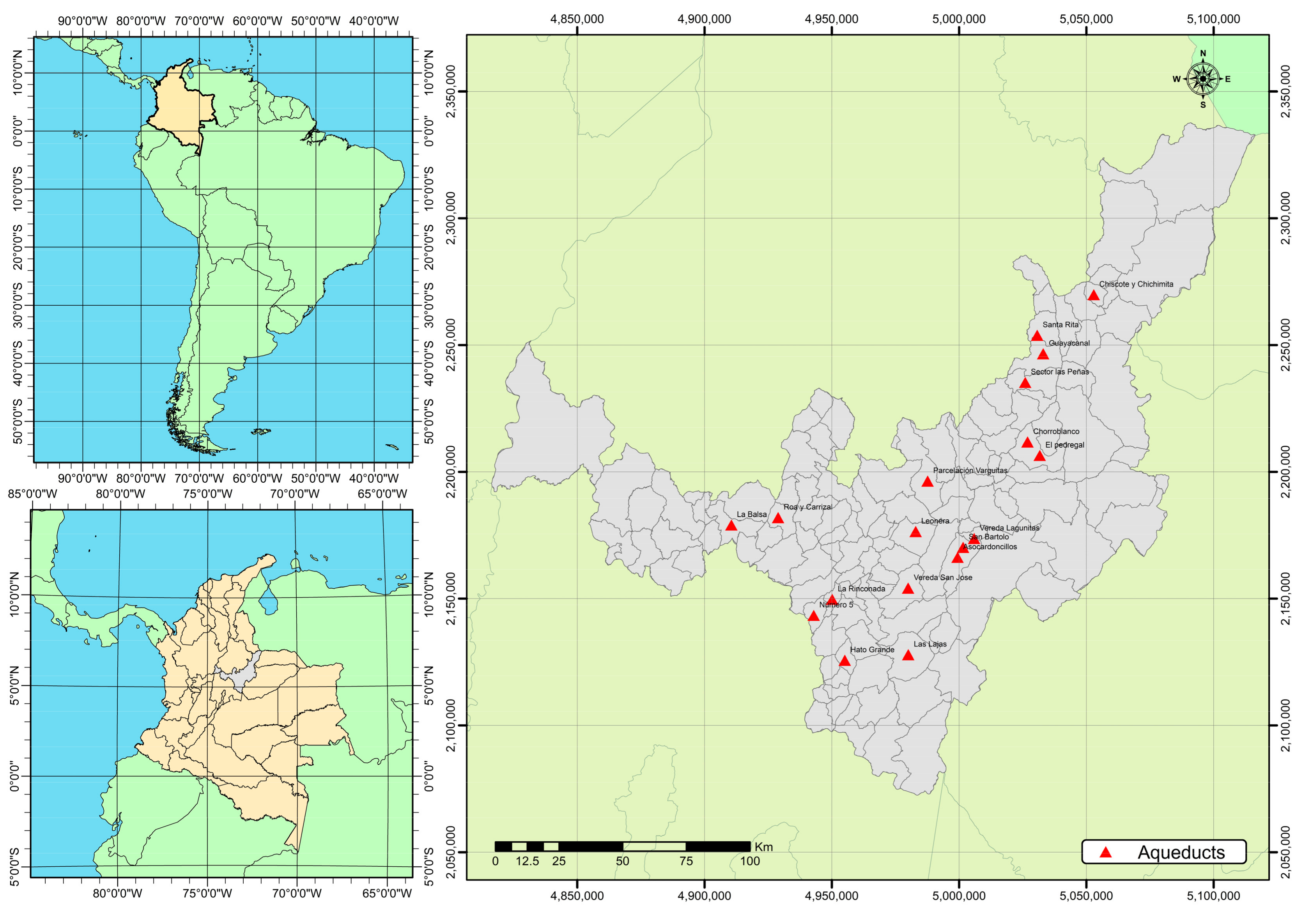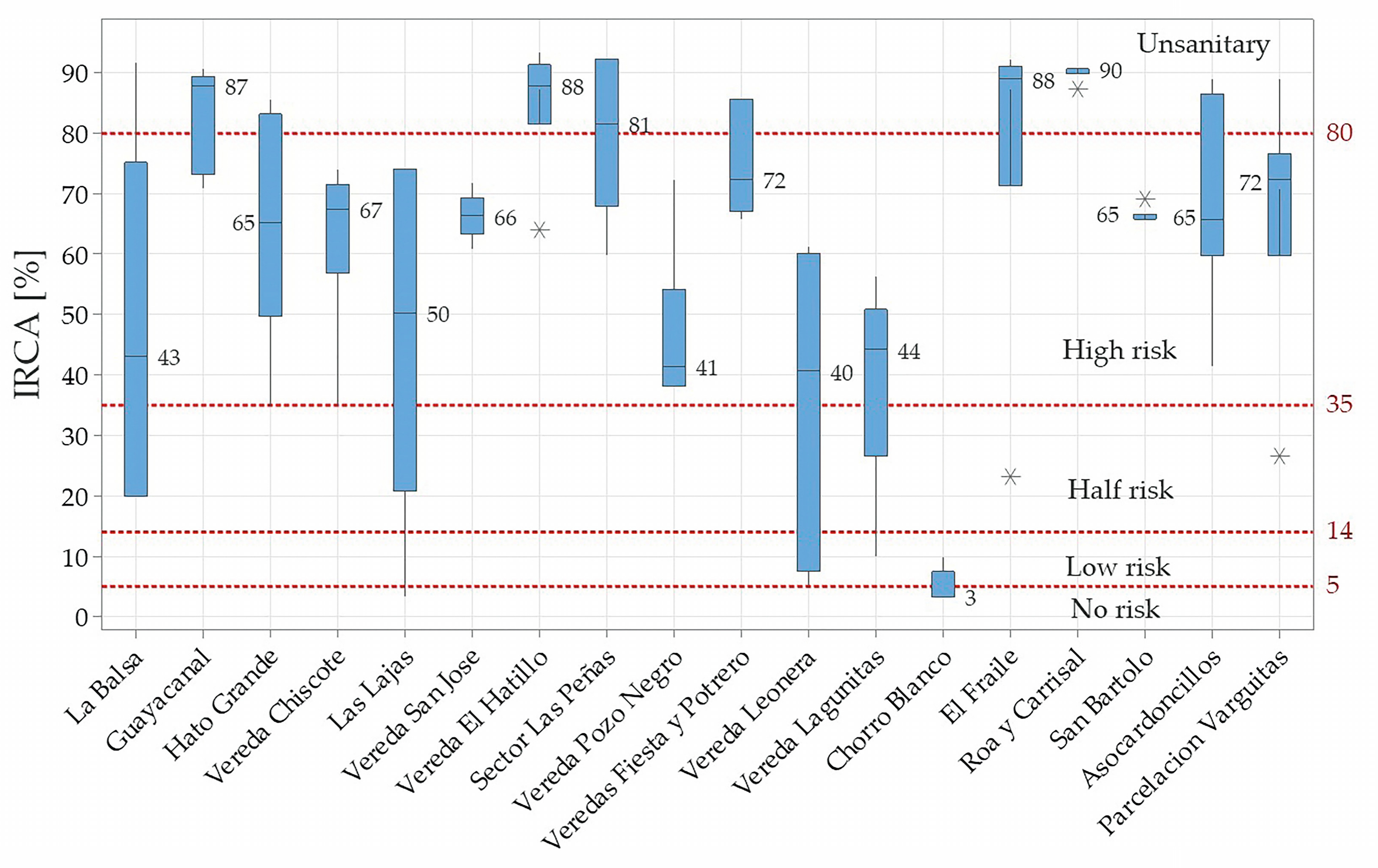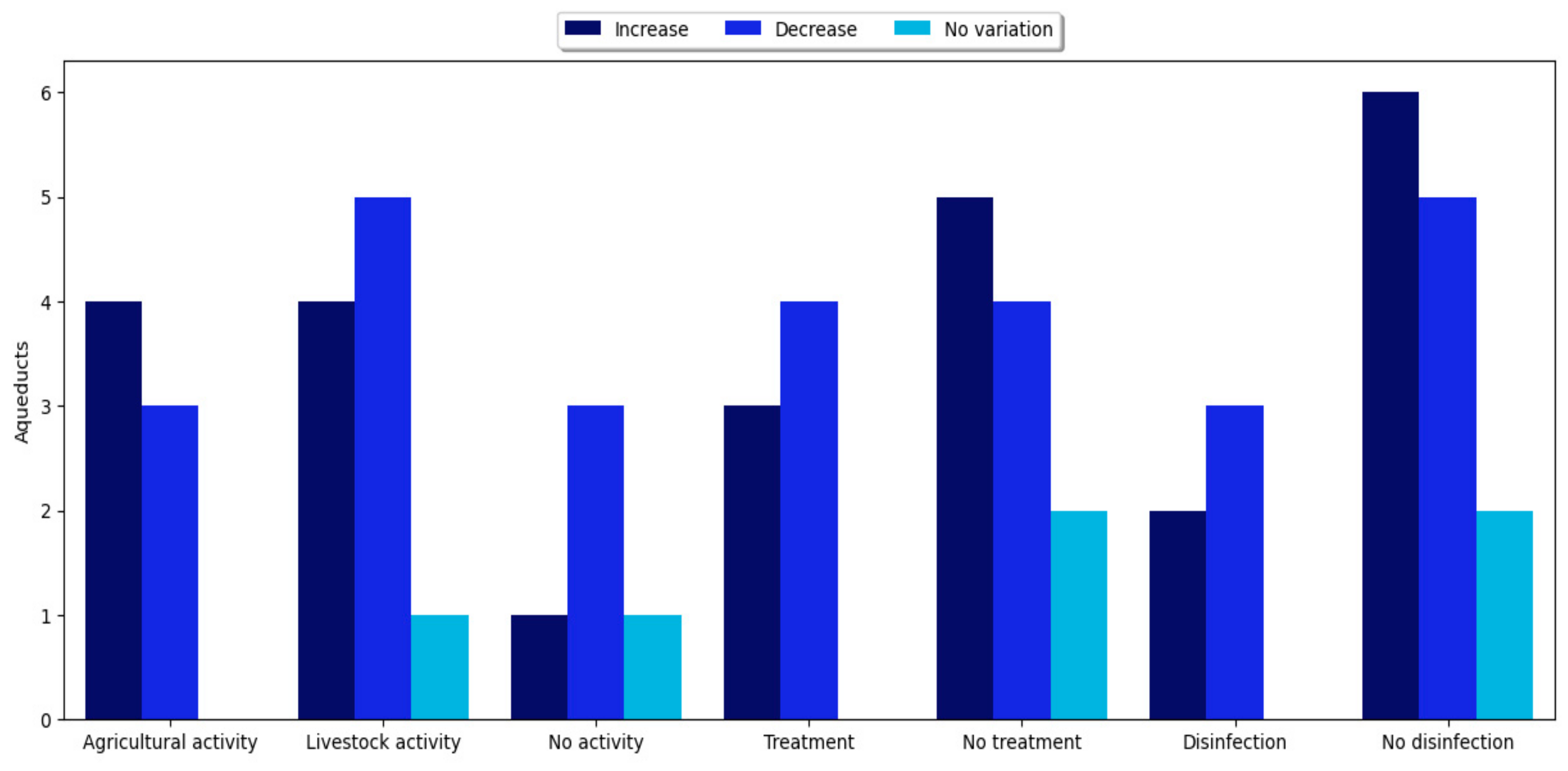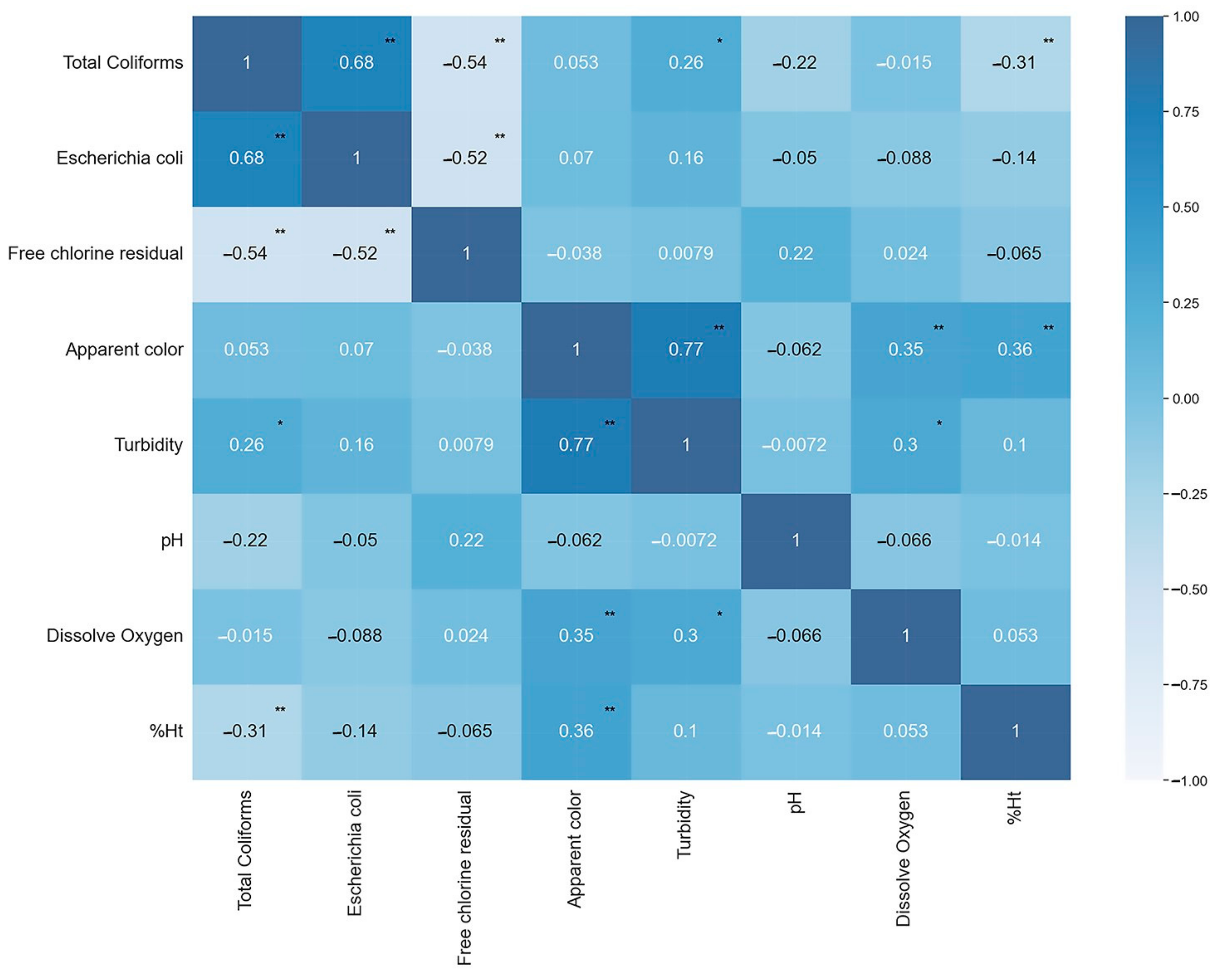Luminescence Toxicological Analysis of Water Supply Systems in Dispersed Rural Areas: A Case Study in Boyacá, Colombia
Abstract
:1. Introduction
2. Materials and Methods
2.1. Description of the Study Area
2.2. Economic Activities Identification
2.3. Water Quality Evaluation
2.4. Bioluminescence Test
- Ht: inhibitory effect of a sample after 30 min (%).
- Ict: the corrected value of for the samples after the addition of the sample.
- ITt: luminescence intensity of the sample after a contact time of 30 min, measured in relative light units (RLU).
2.5. Data Analysis
3. Results
3.1. Description of the Rural Water Supply Systems
3.2. Characterization of Drinking Water Quality
3.3. Bioluminescence Test Results
4. Discussion
5. Conclusions
Author Contributions
Funding
Institutional Review Board Statement
Data Availability Statement
Acknowledgments
Conflicts of Interest
References
- WHO. Guidelines for Drinking-Water Quality Addendum; WHO: Geneva, Switzerland, 2017; Volume 109. [Google Scholar]
- Morrison, K. Stakeholder Involvement in Water Management: Necessity or Luxury? Water Sci. Technol. 2003, 47, 43–51. [Google Scholar] [CrossRef] [PubMed]
- Wen, Y.; Schoups, G.; Van De Giesen, N. Organic Pollution of Rivers: Combined Threats of Urbanization, Livestock Farming and Global Climate Change. Sci. Rep. 2017, 7, 43289. [Google Scholar] [CrossRef] [PubMed] [Green Version]
- Dingemans, M.M.L.; Baken, K.A.; van der Oost, R.; Schriks, M.; van Wezel, A.P. Risk-Based Approach in the Revised European Union Drinking Water Legislation: Opportunities for Bioanalytical Tools. Integr. Environ. Assess. Manag. 2019, 15, 126–134. [Google Scholar] [CrossRef]
- Van De Merwe, J.P.; Neale, P.A.; Melvin, S.D.; Leusch, F.D.L. In Vitro Bioassays Reveal That Additives Are Signi Fi Cant Contributors to the Toxicity of Commercial Household Pesticides. Aquat. Toxicol. 2018, 199, 263–268. [Google Scholar] [CrossRef] [PubMed] [Green Version]
- Yang, Y.; Ok, Y.S.; Kim, K.H.; Kwon, E.E.; Tsang, Y.F. Occurrences and Removal of Pharmaceuticals and Personal Care Products (PPCPs) in Drinking Water and Water/Sewage Treatment Plants: A Review. Sci. Total Environ. 2017, 596–597, 303–320. [Google Scholar] [CrossRef]
- Du, Y.; Lv, X.T.; Wu, Q.Y.; Zhang, D.Y.; Zhou, Y.T.; Peng, L.; Hu, H.Y. Formation and Control of Disinfection Byproducts and Toxicity during Reclaimed Water Chlorination: A Review. J. Environ. Sci. 2017, 58, 51–63. [Google Scholar] [CrossRef]
- Neale, P.A.; Escher, B.I. In Vitro Bioassays to Assess Drinking Water Quality. Curr. Opin. Environ. Sci. Health 2019, 7, 1–7. [Google Scholar] [CrossRef]
- Brunner, A.M.; Dingemans, M.M.L.; Baken, K.A.; van Wezel, A.P. Prioritizing Anthropogenic Chemicals in Drinking Water and Sources through Combined Use of Mass Spectrometry and ToxCast Toxicity Data. J. Hazard. Mater. 2019, 364, 332–338. [Google Scholar] [CrossRef]
- Xu, J.; Wei, D.; Wang, F.; Bai, C.; Du, Y. Bioassay: A Useful Tool for Evaluating Reclaimed Water Safety. J. Environ. Sci. 2019, 88, 165–176. [Google Scholar] [CrossRef]
- Pedrazzani, R.; Bertanza, G.; Brnardić, I.; Cetecioglu, Z.; Dries, J.; Dvarionienė, J.; García-Fernández, A.J.; Langenhoff, A.; Libralato, G.; Lofrano, G.; et al. Opinion Paper about Organic Trace Pollutants in Wastewater: Toxicity Assessment in a European Perspective. Sci. Total Environ. 2019, 651, 3202–3221. [Google Scholar] [CrossRef]
- Diaz-Sosa, V.R.; Tapia-Salazar, M.; Wanner, J.; Cardenas-Chavez, D.L. Monitoring and Ecotoxicity Assessment of Emerging Contaminants in Wastewater Discharge in the City of Prague (Czech Republic). Water 2020, 12, 1079. [Google Scholar] [CrossRef] [Green Version]
- De Castro-Català, N.; Kuzmanovic, M.; Roig, N.; Sierra, J.; Ginebreda, A.; Barceló, D.; Pérez, S.; Petrovic, M.; Picó, Y.; Schuhmacher, M.; et al. Ecotoxicity of Sediments in Rivers: Invertebrate Community, Toxicity Bioassays and the Toxic Unit Approach as Complementary Assessment Tools. Sci. Total Environ. 2016, 540, 297–306. [Google Scholar] [CrossRef] [Green Version]
- Schreiber, B.; Fischer, J.; Schiwy, S.; Hollert, H.; Schulz, R. Towards More Ecological Relevance in Sediment Toxicity Testing with Fish: Evaluation of Multiple Bioassays with Embryos of the Benthic Weatherfish (Misgurnus fossilis). Sci. Total Environ. 2018, 619–620, 391–400. [Google Scholar] [CrossRef]
- Gomes, O., Jr.; Borges Neto, W.; Machado, A.E.H.; Daniel, D.; Trovó, A.G. Optimization of Fipronil Degradation by Heterogeneous Photocatalysis: Identification of Transformation Products and Toxicity Assessment. Water Res. 2017, 110, 133–140. [Google Scholar] [CrossRef]
- Kołtowski, M.; Charmas, B.; Skubiszewska-Zięba, J.; Oleszczuk, P. Effect of Biochar Activation by Different Methods on Toxicity of Soil Contaminated by Industrial Activity. Ecotoxicol. Environ. Saf. 2017, 136, 119–125. [Google Scholar] [CrossRef]
- Abbas, M.; Adil, M.; Ehtisham-ul-Haque, S.; Munir, B.; Yameen, M.; Ghaffar, A.; Shar, G.A.; Asif Tahir, M.; Iqbal, M. Vibrio Fischeri Bioluminescence Inhibition Assay for Ecotoxicity Assessment: A Review. Sci. Total Environ. 2018, 626, 1295–1309. [Google Scholar] [CrossRef]
- Barceló, D.; Žonja, B.; Ginebreda, A. Toxicity Tests in Wastewater and Drinking Water Treatment Processes: A Complementary Assessment Tool to Be on Your Radar. J. Environ. Chem. Eng. 2020, 8, 104262. [Google Scholar] [CrossRef]
- Yu, D.; Wang, Q.; Fang, Y.; Kang, Z.; Liu, L.; He, J.; Han, X.; Yu, H.; Dong, S. Study on Simplified Strategies for Procedure of Rapid Detection of Water Toxicity. Talanta 2021, 235, 122787. [Google Scholar] [CrossRef]
- Mendonça, E.; Picado, A.; Paixão, S.M.; Silva, L.; Cunha, M.A.; Leitão, S.; Moura, I.; Cortez, C.; Brito, F. Ecotoxicity Tests in the Environmental Analysis of Wastewater Treatment Plants: Case Study in Portugal. J. Hazard. Mater. 2009, 163, 665–670. [Google Scholar] [CrossRef]
- Kudryasheva, N.S. Bioluminescence and Exogenous Compounds: Physico-Chemical Basis for Bioluminescent Assay. J. Photochem. Photobiol. B Biol. 2006, 83, 77–86. [Google Scholar] [CrossRef]
- Tzani, M.A.; Gioftsidou, D.K.; Kallitsakis, M.G.; Pliatsios, N.V.; Kalogiouri, N.P.; Angaridis, P.A.; Lykakis, I.N.; Terzidis, M.A. Direct and Indirect Chemiluminescence: Reactions, Mechanisms and Challenges. Molecules 2021, 26, 29. [Google Scholar] [CrossRef] [PubMed]
- Kaeding, A.J.; Ast, J.C.; Pearce, M.M.; Urbanczyk, H.; Kimura, S.; Endo, H.; Nakamura, M.; Dunlap, P.V. Phylogenetic Diversity and Cosymbiosis in the Bioluminescent Symbioses of “Photobacterium Mandapamensis”. Appl. Environ. Microbiol. 2007, 73, 3173–3182. [Google Scholar] [CrossRef] [PubMed] [Green Version]
- Schulz, W.; Seitz, W.; Weiss, S.C.; Weber, W.H.; Böhm, M.; Flottmann, D. Use of Vibrio Fischeri for Screening for Bioactivity in Water Analysis. J. Planar Chromatogr. Mod. TLC 2008, 21, 427–430. [Google Scholar] [CrossRef]
- Westlund, P.; Nasuhoglu, D.; Isazadeh, S.; Yargeau, V. Investigation of Acute and Chronic Toxicity Trends of Pesticides Using High-Throughput Bioluminescence Assay Based on the Test Organism Vibrio Fischeri. Arch. Environ. Contam. Toxicol. 2018, 74, 557–567. [Google Scholar] [CrossRef] [PubMed]
- Christensen, D.G.; Visick, K.L. Vibrio Fischeri: Laboratory Cultivation, Storage, and Common Phenotypic Assays. Curr. Protoc. Microbiol. 2020, 57, e103. [Google Scholar] [CrossRef]
- Yi, X.; Gao, Z.; Liu, L.; Zhu, Q.; Hu, G.; Zhou, X. Acute Toxicity Assessment of Drinking Water Source with Luminescent Bacteria: Impact of Environmental Conditions and a Case Study in Luoma Lake, East China. Front. Environ. Sci. Eng. 2020, 14, 109. [Google Scholar] [CrossRef]
- Strotmann, U.; Flores, D.P.; Konrad, O.; Gendig, C. Bacterial Toxicity Testing: Modification and Evaluation of the Luminescent Bacteria Test and the Respiration Inhibition Test. Processes 2020, 8, 1349. [Google Scholar] [CrossRef]
- Grande, R.; Di Pietro, S.; Di Campli, E.; Di Bartolomeo, S.; Filareto, B.; Cellini, L. Bio-Toxicological Assays to Test Water and Sediment Quality. J. Environ. Sci. Health Part A 2007, 42, 33–38. [Google Scholar] [CrossRef]
- Villanueva, C.M.; Evlampidou, I.; Ibrahim, F.; Donat-Vargas, C.; Valentin, A.; Tugulea, A.M.; Echigo, S.; Jovanovic, D.; Lebedev, A.T.; Lemus-Pérez, M.; et al. Global Assessment of Chemical Quality of Drinking Water: The Case of Trihalomethanes. Water Res. 2023, 230, 119568. [Google Scholar] [CrossRef]
- Galezzo, M.A.; Rodríguez Susa, M. The Challenges of Monitoring and Controlling Drinking-Water Quality in Dispersed Rural Areas: A Case Study Based on Two Settlements in the Colombian Caribbean. Environ. Monit. Assess. 2021, 193, 1–13. [Google Scholar] [CrossRef]
- Binder, C.; Schertenleib, R.; Diaz, J.; Bader, H.-P.; Baccini, P. Regional Water Balance as a Tool for Water Management in Developing Countries. Int. J. Water Resour. Dev. 1997, 13, 5–20. [Google Scholar] [CrossRef]
- Pérez-Vidal, A.; Escobar-Rivera, J.C.; Torres-Lozada, P. Development and Implementation of a Water-Safety Plan for Drinking-Water Supply System of Cali, Colombia. Int. J. Hyg. Environ. Health 2020, 224, 113422. [Google Scholar] [CrossRef]
- APHA. Standard Methods for the Examination of Water and Wastewater Standard Methods for the Examination of Water and Wastewater; American Public Health Association: Washington, DC, USA, 2009. [Google Scholar]
- Ministerio de la Protección Social; Ministerio de Ambiente Vivienda y Desarrollo Territorial. M. Resolución 2115 de 2007, Bogotá, Colombia. Available online: https://minvivienda.gov.co/sites/default/files/normativa/2115%20-%202007.pdf (accessed on 24 May 2023).
- ISO. Water Quality—Determination of the Inhibitory Effect of Water Samples on the Light Emission of Vibrio Fischeri (Luminescent Bacteria Test); International Organization for Standarization: London, UK, 2008. [Google Scholar]
- Persoone, G.; Marsalek, B.; Blinova, I.; Törökne, A.; Zarina, D.; Manusadzianas, L.; Nalecz-Jawecki, G.; Tofan, L.; Stepanova, N.; Tothova, L.; et al. A Practical and User-Friendly Toxicity Classification System with Microbiotests for Natural Waters and Wastewaters. Environ. Toxicol. 2003, 18, 395–402. [Google Scholar] [CrossRef]
- Naghettini, M. Fundamentals of Statistical Hydrology; Springer International Publishing: Cham, Switzerland, 2016. [Google Scholar] [CrossRef]
- Ramos-Parra, Y.J.; Pinilla-Roncancio, M.V. Calidad de Agua de Consumo Humano En Sistemas de Abastecimiento Rurales En Boyacá, Colombia. Un Análisis Water Quality for Human Consumption in Rural Supply Systems in Boyacá, Colombia. An Infrastructural Analysis. Rev. EIA 2020, 17, 219–233. [Google Scholar]
- Esimbekova, E.N.; Kondik, A.M.; Kratasyuk, V.A. Bioluminescent Enzymatic Rapid Assay of Water Integral Toxicity. Environ. Monit. Assess. 2013, 185, 5909–5916. [Google Scholar] [CrossRef]
- Martínez, M.; Osorio, A. Validation of a Method for Real Color Analysis in Water. Fac. De Cienc. 2018, 7, 143–155. [Google Scholar]
- Tarasova, A.S.; Stom, D.I.; Kudryasheva, N.S. Antioxidant Activity of Humic Substances via Bioluminescent Monitoring in Vitro. Environ. Monit. Assess. 2015, 187, 89. [Google Scholar] [CrossRef]
- Alengebawy, A.; Abdelkhalek, S.T.; Qureshi, S.R.; Wang, M.Q. Heavy Metals and Pesticides Toxicity in Agricultural Soil and Plants: Ecological Risks and Human Health Implications. Toxics 2021, 9, 42. [Google Scholar] [CrossRef]
- Cukurluoglu, S.; Muezzinoglu, A. Assessment of Toxicity in Waters Due to Heavy Metals Derived from Atmospheric Deposition Using Vibrio Fischeri. J. Environ. Sci. Health—Part A 2013, 48, 57–66. [Google Scholar] [CrossRef]
- Reza, R.; Singh, G. Heavy Metal Contamination and Its Indexing Approach for River Water. Int. J. Environ. Sci. Technol. 2010, 7, 785–792. [Google Scholar] [CrossRef] [Green Version]
- Taufique Arefin, M.; Mokhlesur Rahman, M.; Wahid-U-Zzaman, M.; Kim, J.E. Appraisal of Heavy Metal Status in Water for Irrigation Usage of the Bangshi River, Bangladesh. Appl. Biol. Chem. 2016, 59, 729–737. [Google Scholar] [CrossRef]
- Tsiridis, V.; Petala, M.; Samaras, P.; Hadjispyrou, S.; Sakellaropoulos, G.; Kungolos, A. Interactive Toxic Effects of Heavy Metals and Humic Acids on Vibrio Fischeri. Ecotoxicol. Environ. Saf. 2006, 63, 158–167. [Google Scholar] [CrossRef] [PubMed]
- Gomes, A.I.; Pires, J.C.M.; Figueiredo, S.A.; Boaventura, R.A.R. Multiple Linear and Principal Component Regressions for Modelling Ecotoxicity Bioassay Response. Environ. Technol. 2014, 35, 945–955. [Google Scholar] [CrossRef]






| Parameter | Risk Score |
|---|---|
| Apparent Color | 6 |
| Turbidity | 15 |
| pH | 1.5 |
| Free residual chlorine | 15 |
| Total alkalinity | 1 |
| Calcium | 1 |
| Manganese | 1 |
| Hardness | 1 |
| Sulfates | 1 |
| Chlorides | 1 |
| Nitrates | 1 |
| Nitrites | 3 |
| Fluorides | 1 |
| TOC | 3 |
| Total Coliforms | 15 |
| Escherichia Coli | 25 |
| Sum of scores | 92 |
| %Ht | Class | Level Risk |
|---|---|---|
| ≤20% | Class I | No acute hazard |
| 20 ≤ Ht ≤ 50% | Class II | Moderate acute hazard |
| 50 ≤ Ht ≤ 100% | Class III | Acute hazard |
| Ht 100% in at least one test | Class IV | High acute hazard |
| Ht 100% in all tests | Class V | Very high acute hazard |
| Aqueduct | Water Source | Water Treatment | Disinfection | Economic Activity | |
|---|---|---|---|---|---|
| La Balsa | Spring | No | No | Agriculture | |
| Vereda Lagunitas | Lake | Yes | Yes | Livestock | Agriculture |
| Roa y Carrisal | Creek | No | No | No reported | |
| Hato Grande | Spring | Yes | Yes | Livestock | |
| Veredas Fiesta y Potreros | Spring | No | No | No reported | |
| Las Lajas | Spring | Yes | Yes | Livestock | |
| Vereda San Jose | Spring | No | No | Livestock | |
| Vereda Leonera | Lake | Yes | Yes | Livestock | Agriculture |
| Parcelacion Varguitas | Creek | Yes | No | Livestock | |
| Guayacanal | Creek | No | No | No reported | |
| Vereda Chiscote | Creek | Yes | No | No reported | |
| Vereda el Hatillo | Creek | No | No | Livestock | Agriculture |
| Sector las Peñas | Spring | No | No | No reported | |
| El Fraile | Creek | Yes | Yes | Livestock | Mining |
| Chorro Blanco | Creek | No | No | Livestock | Agriculture |
| Vereda Pozo Negro | Creek | No | No | Livestock | |
| Asocardoncillos | Spring | No | No | Agriculture | Domestic |
| Bartolo | Spring | No | No | Agriculture | Domestic |
| Parameter | Source | Treatment | Distribution Network |
|---|---|---|---|
| Mean (sd) | |||
| Total coliforms NMP/100 mL | 1163 (1053.39) | 827 (1020.99) | 1103 (847.14) |
| Escherichia coli NMP/100 mL | 66 (178.97) | 22 (159.90) | 52 (68.58) |
| Free residual chlorine mg/LCl2 | 0 (0.369) | 0.14 (0.368) | 0.18 (0.32) |
| Apparent color UPC | 29 (28.20) | 26 (41.57) | 32 (43.57) |
| Turbidity NTU | 2.86 (3.84) | 3.27 (3.48) | 2.57 (6.79) |
| pH | 6.46 (0.95) | 6.95 (1.10) | 6.75 (0.77) |
| Dissolved oxygen mg/L | 6.41 (1.48) | 6.74 (1.23) | 6.69 (1.41) |
| Aqueduct | IRCA (%) Average | Standard Deviation | * CI (95%) | Minimum | Maximum |
|---|---|---|---|---|---|
| La Balsa | 47.8 | 28.3 | 18–78 | 19.8 | 91.7 |
| Guayacanal | 83 | 8.6 | 74–92 | 70 | 91 |
| Hato Grande | 65 | 20 | 44–85 | 34 | 85 |
| Chiscote | 63 | 14 | 48–78 | 19 | 61 |
| Las Lajas | 46 | 30 | 14–78 | 3 | 74 |
| San Jose | 66 | 3 | 62–70 | 60 | 71 |
| El Hatillo | 85 | 10 | 74–96 | 64 | 93 |
| Sector Las Peñas | 79 | 13 | 65–93 | 59 | 92 |
| Pozo Negro | 46 | 13 | 32–60 | 38 | 72 |
| Fiesta y Potrero | 74 | 8 | 65–84 | 65 | 85 |
| Leonera | 35 | 24 | 10–62 | 5 | 61 |
| Lagunitas | 39 | 16 | 24–54 | 9 | 56 |
| Chorro Blanco | 4.9 | 2.7 | 2–8 | 3 | 9 |
| El Fraile | 78 | 27 | 50–107 | 23 | 92 |
| Roa y Carrisal | 90 | 1.3 | 88–91 | 87 | 90 |
| San Bartolo | 66 | 1.3 | 64–77 | 65 | 99 |
| Asocardoncillos | 68 | 17 | 51–87 | 41 | 88 |
| Parcelacion Varguitas | 67 | 21 | 45–89 | 25 | 88 |
| Aqueduct | %Ht | ||
|---|---|---|---|
| Water Source | Treatment System | Distribution Network | |
| La Balsa | 64 | 74 | 78 |
| Vereda Lagunitas | 41 | 41 | 49 |
| Roa y Carrisal | 72 | 69 | 65 |
| Hato Grande | 64 | 45 | 68 |
| Veredas Fiesta y Potreros | 51 | 66 | 51 |
| Las Lajas | 80 | 79 | 79 |
| Vereda San Jose | 64 | 64 | 74 |
| Vereda Leonera | 87 | 68 | 70 |
| Parcelación Varguitas | 38 | 65 | 54 |
| Guayacanal | 97 | 53 | 55 |
| Vereda Chiscote | 96 | 57 | 46 |
| Vereda el Hatillo | 84 | 79 | 83 |
| Sector las Peñas | 79 | 75 | 81 |
| el Fraile | 84 | 72 | 59 |
| Chorro Blanco | 80 | 71 | 57 |
| Vereda Pozo Negro | 81 | 81 | 81 |
| Asocardoncillos | 52 | 77 | 61 |
| San Bartolo | 52 | 61 | 54 |
Disclaimer/Publisher’s Note: The statements, opinions and data contained in all publications are solely those of the individual author(s) and contributor(s) and not of MDPI and/or the editor(s). MDPI and/or the editor(s) disclaim responsibility for any injury to people or property resulting from any ideas, methods, instructions or products referred to in the content. |
© 2023 by the authors. Licensee MDPI, Basel, Switzerland. This article is an open access article distributed under the terms and conditions of the Creative Commons Attribution (CC BY) license (https://creativecommons.org/licenses/by/4.0/).
Share and Cite
Ramos-Parra, Y.J.; Díaz-Gómez, J.; Mesa-Torres, M.V.; Torres-Piraquive, S.D.; Zipa-Casas, N.Y.; Suescún-Carrero, S.; Medina-Alfonso, M. Luminescence Toxicological Analysis of Water Supply Systems in Dispersed Rural Areas: A Case Study in Boyacá, Colombia. Water 2023, 15, 2474. https://doi.org/10.3390/w15132474
Ramos-Parra YJ, Díaz-Gómez J, Mesa-Torres MV, Torres-Piraquive SD, Zipa-Casas NY, Suescún-Carrero S, Medina-Alfonso M. Luminescence Toxicological Analysis of Water Supply Systems in Dispersed Rural Areas: A Case Study in Boyacá, Colombia. Water. 2023; 15(13):2474. https://doi.org/10.3390/w15132474
Chicago/Turabian StyleRamos-Parra, Yadi Johaira, Jaime Díaz-Gómez, Mónica Viviana Mesa-Torres, Sergio David Torres-Piraquive, Nohora Yaneth Zipa-Casas, Sandra Suescún-Carrero, and Mabel Medina-Alfonso. 2023. "Luminescence Toxicological Analysis of Water Supply Systems in Dispersed Rural Areas: A Case Study in Boyacá, Colombia" Water 15, no. 13: 2474. https://doi.org/10.3390/w15132474





